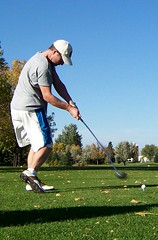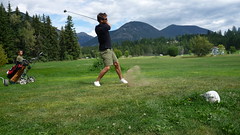PART 1: Tiger’s Modern Swing Setup
 Photo by Keith Allison
I consider myself a golf historian, though admittedly my interest leans mostly toward the realm of golf instruction. In fact, in my library I’ve got over one hundred how-to books, my at home office walls are covered with swing sequence photographs of golf greats, and my desk drawers contain golf videotapes and electronic media of all types, plus binders containing instruction articles cut out of major golf magazines. On top of that, I’ve attended approximately 25 golf schools around the world, and when not attending a golf tournament, constantly watch golf on television. I live golf instruction!
In searching all these years for the answers to the perfect swing, I’ve tested out all kinds of swing methods, including the most popular and the most obscure, and observed closely the swings of top tour pros from past and present eras.
In tracking the actions of Tour professionals, the players I pay the closest attention to simply because they have proven themselves to be the best golf club swingers and golf scorers in the world, I’ve noticed that over the last ten years gradual changes have been occurring in the techniques of more and more top players. These changes have all been quite subtle in nature and, again, so gradual that the leading golf magazines have not reported on them. Furthermore, until the 2007 PGA championship, no one player had employed all of the elements of what was being built before your eyes without you knowing it: The Modern Golf Swing.
In all fairness, the chief reason this modern golf creation was virtually impossible to see was because players were modernizing their setup, backswing, and downswing piecemeal, and by feel or instinct alone. Moreover, one player would change only one address key, another player only one backswing key, another one downswing key, and so on. Therefore, these changes went unnoticeable. No one golfer had it all together, a handle on the complete Modern Swing package, but that was all to change.
My trained eye and my constant tracking of what goes on in the world of golf instruction is what allowed me to discover the one player who was smart enough to figure out the entire puzzle and piece each piece together into one super-efficient package. Furthermore, this player operated according to a plan, making conscious decisions to risk everything he had accomplished to try and bring his technique to the highest possible level. This shows the genius and the courage of that one player. Who is this one player who has assembled the Modern Swing that will now be our model for the future and allow him to play golf even better than before and likely overtake Jack Nicklaus’s major championship record of 18 major championships? Why, of course, it’s Tiger Woods, the world’s greatest golfer, who just so happens to be the most determined golfer, who just so happens to be the golfer who most thinks outside the box when meditating on golf technique.
What’s even more ironic is Tiger Woods is setting the trend, but he’s such a phenomenon and gone through so many teachers and methods that the press and golf swing aficionados have failed to notice the changes Tiger has made to his setup and swing. That’s why you have not heard any golf commentator mention Tiger’s accomplishment or, up until now, ever read about Tiger discovering and employing The Modern Swing.
I spoke about this at length in one of my books, Tiger’s New Swing. However, since its publication in 2005, Tiger has modernized his swing. And as one golf insider told me, Tiger did the work himself (mostly after failing to win the first three major championships of 2007), and that makes sense, considering he knows more about golf technique than anyone in the world.
THE MODERN SWING SETUP
* Teach Your Students to Follow These Instructions
When setting up to drive, position the ball an inch behind your left heel, tee the ball lower than normal, so that the leading edge of the driver’s face is even or just a tad below the top of the ball. Just recently, Tiger
changed the position of the ball, moving it back slightly. Tiger also started teeing the ball lower to discourage an exaggerated upswing hit and, instead, encourage what renowned teacher Jim McLean calls a more streamlined “flat spot” in the hitting area, and as a result, a more level strike. By level strike, I mean that the club moves low along the target line through impact and stays on the ball for a split second longer. The result:
more solid, clubface-to-ball contact, less backspin imparted on the ball, and a lower, more piercing ball flight.
I’ve also noticed that rather than set his hands a couple of inches behind the ball, a la Ben Hogan, in order to promote a low and long takeaway, Tiger sets them slightly ahead. This new “modernized” position promotes a more upright swing plane, very different than the flat swing Tiger learned under Butch Harmon. So, I suppose Tiger now believes what his idol Jack Nicklaus always believed, and what we should all accept as fact:
“An upright plane gives the golfer his best chance of swinging the club along the target line at impact.”
Two other setup changes to Tiger’s swing that are both tied to one another involve the left hip and the distribution of weight. Whereas Tiger used to set slightly more weight on his right foot and tilt his left hip up, to promote an upswing hit, he now sets up with his weight evenly balanced and his hips dead level.
These modernized changes of Tiger, plus setting his head more in line with the ball than well behind it, point to the modern-day golfer looking for added distance via a lower flying tee shot that will roll out farther upon landing, rather than a tee ball hit with plenty of carry.
Last, but certainly not least, Tiger’s grip is neutral to strong, instead of on the weak side, and his stance square rather than open, proving that he is trying to gram a straight ball or slight draw into his shotmaking repertoire rather than his old bread-and-butter high flying fade that, unfortunately, sometimes turned into a slice. Sometimes, too, when fearing hitting a shot right of target, Tiger would try to flip the club back to square at impact, end up closing the clubface, and hitting a duck-hook.
Have your students work on the aforementioned address keys until they become second nature. At that
point, they will be ready to learn and groove Tiger’s backswing and downswing keys.
Photo by Keith Allison
I consider myself a golf historian, though admittedly my interest leans mostly toward the realm of golf instruction. In fact, in my library I’ve got over one hundred how-to books, my at home office walls are covered with swing sequence photographs of golf greats, and my desk drawers contain golf videotapes and electronic media of all types, plus binders containing instruction articles cut out of major golf magazines. On top of that, I’ve attended approximately 25 golf schools around the world, and when not attending a golf tournament, constantly watch golf on television. I live golf instruction!
In searching all these years for the answers to the perfect swing, I’ve tested out all kinds of swing methods, including the most popular and the most obscure, and observed closely the swings of top tour pros from past and present eras.
In tracking the actions of Tour professionals, the players I pay the closest attention to simply because they have proven themselves to be the best golf club swingers and golf scorers in the world, I’ve noticed that over the last ten years gradual changes have been occurring in the techniques of more and more top players. These changes have all been quite subtle in nature and, again, so gradual that the leading golf magazines have not reported on them. Furthermore, until the 2007 PGA championship, no one player had employed all of the elements of what was being built before your eyes without you knowing it: The Modern Golf Swing.
In all fairness, the chief reason this modern golf creation was virtually impossible to see was because players were modernizing their setup, backswing, and downswing piecemeal, and by feel or instinct alone. Moreover, one player would change only one address key, another player only one backswing key, another one downswing key, and so on. Therefore, these changes went unnoticeable. No one golfer had it all together, a handle on the complete Modern Swing package, but that was all to change.
My trained eye and my constant tracking of what goes on in the world of golf instruction is what allowed me to discover the one player who was smart enough to figure out the entire puzzle and piece each piece together into one super-efficient package. Furthermore, this player operated according to a plan, making conscious decisions to risk everything he had accomplished to try and bring his technique to the highest possible level. This shows the genius and the courage of that one player. Who is this one player who has assembled the Modern Swing that will now be our model for the future and allow him to play golf even better than before and likely overtake Jack Nicklaus’s major championship record of 18 major championships? Why, of course, it’s Tiger Woods, the world’s greatest golfer, who just so happens to be the most determined golfer, who just so happens to be the golfer who most thinks outside the box when meditating on golf technique.
What’s even more ironic is Tiger Woods is setting the trend, but he’s such a phenomenon and gone through so many teachers and methods that the press and golf swing aficionados have failed to notice the changes Tiger has made to his setup and swing. That’s why you have not heard any golf commentator mention Tiger’s accomplishment or, up until now, ever read about Tiger discovering and employing The Modern Swing.
I spoke about this at length in one of my books, Tiger’s New Swing. However, since its publication in 2005, Tiger has modernized his swing. And as one golf insider told me, Tiger did the work himself (mostly after failing to win the first three major championships of 2007), and that makes sense, considering he knows more about golf technique than anyone in the world.
THE MODERN SWING SETUP
* Teach Your Students to Follow These Instructions
When setting up to drive, position the ball an inch behind your left heel, tee the ball lower than normal, so that the leading edge of the driver’s face is even or just a tad below the top of the ball. Just recently, Tiger
changed the position of the ball, moving it back slightly. Tiger also started teeing the ball lower to discourage an exaggerated upswing hit and, instead, encourage what renowned teacher Jim McLean calls a more streamlined “flat spot” in the hitting area, and as a result, a more level strike. By level strike, I mean that the club moves low along the target line through impact and stays on the ball for a split second longer. The result:
more solid, clubface-to-ball contact, less backspin imparted on the ball, and a lower, more piercing ball flight.
I’ve also noticed that rather than set his hands a couple of inches behind the ball, a la Ben Hogan, in order to promote a low and long takeaway, Tiger sets them slightly ahead. This new “modernized” position promotes a more upright swing plane, very different than the flat swing Tiger learned under Butch Harmon. So, I suppose Tiger now believes what his idol Jack Nicklaus always believed, and what we should all accept as fact:
“An upright plane gives the golfer his best chance of swinging the club along the target line at impact.”
Two other setup changes to Tiger’s swing that are both tied to one another involve the left hip and the distribution of weight. Whereas Tiger used to set slightly more weight on his right foot and tilt his left hip up, to promote an upswing hit, he now sets up with his weight evenly balanced and his hips dead level.
These modernized changes of Tiger, plus setting his head more in line with the ball than well behind it, point to the modern-day golfer looking for added distance via a lower flying tee shot that will roll out farther upon landing, rather than a tee ball hit with plenty of carry.
Last, but certainly not least, Tiger’s grip is neutral to strong, instead of on the weak side, and his stance square rather than open, proving that he is trying to gram a straight ball or slight draw into his shotmaking repertoire rather than his old bread-and-butter high flying fade that, unfortunately, sometimes turned into a slice. Sometimes, too, when fearing hitting a shot right of target, Tiger would try to flip the club back to square at impact, end up closing the clubface, and hitting a duck-hook.
Have your students work on the aforementioned address keys until they become second nature. At that
point, they will be ready to learn and groove Tiger’s backswing and downswing keys.









